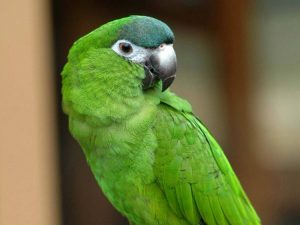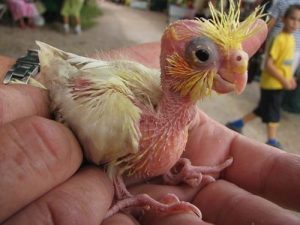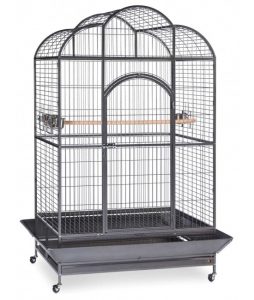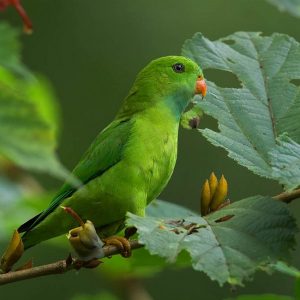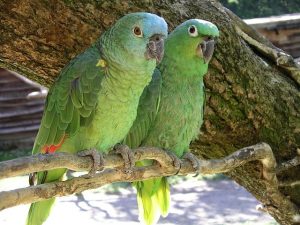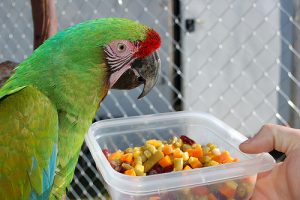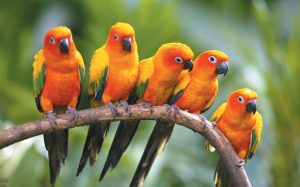Parrots
Parrots are a family of birds with around 400 species. A typical parrot’s characteristic features are its vibrant colors and the downward-curving bill, with a strong, highly dexterous tongue. They are among the most strikingly colored birds, especially the macaw, rosella, and amazon. The most notable types include the scarlet macaw, eastern rosella, Eclectus parrot, and the blue-fronted amazon.
Different Types of Parrots
They are divided into 3 superfamilies: true parrots (Psittacoidea), cockatoos (Cacatuoidea), and New Zealand parrots (Strigopoidea).
True Parrots (Psittacoidea)
Parrots, macaws, amazons, conures, parakeets, and lorikeets belong to the true parrot subfamily.
- African Grey Parrot
- Eclectus Parrot
- Senegal Parrot
- Alexandrine Parrot
- Meyer’s Parrot
- Cape Parrot
- Blue and Gold Macaw
- Hyacinth Macaw
- Scarlet Macaw
- Hahn’s Macaw
- Spix’s Macaw
- Patagonian Conure
- Sun Conure
- Pacific Parrotlet
- Ringneck Parakeet
- Plum-headed Parakeet
- Black-Cheeked Lovebird
- Fischer’s Lovebird
- Finsch’s Pygmy Parrot
- Meek’s Pygmy Parrot
- Rainbow Lorikeet
- Black-Headed Caique
- Blue-streaked Lory
- Blue-Fronted Amazon
- White-fronted Amazon
- Lilac-crowned Amazon
- Yellow-crowned Amazon
- Orange-winged Amazon
- Yellow-naped Amazon
- Double Yellow-headed Amazon
- Red-lored Amazon
- Hawk-headed Parrot
- Vasa Parrot (Black Parrot)
- Red Lory
- Jardine Parrot
- White-bellied Caique
- Princess Parrot
- Crimson Rosella
- White-capped Pionus
- Eastern Rosella
- Red-bellied Parrot
- Timneh African Grey
- Blue-headed Pionus
Cockatoos (Cacatuoidea)
- Major Mitchell’s Cockatoo
- Black Palm Cockatoo
- Rose-Breasted Cockatoo (Galah)
- Goffin’s Cockatoo
- Moluccan Cockatoo
- Cockatiel
- Pied Cockatiel
- Lutino Cockatiel
- Bare-Eyed Cockatoo
New Zealand Parrots (Strigopoidea)
- New Zealand Kākā (South Island and North Island Kākā)
- Kakapo
- Kea
Types of Parrots By Color
Habitat
These birds are well-spread across most tropical and sub-tropical regions of the world, with the most considerable variation seen in Australasia and South America.
Mating & breeding
Most parrot species practice monogamy, with few exceptions. The loss of a partner usually irreversibly depresses the other. Females lay between 2-4 eggs, white in color, which they proceed to incubate for around 17 to 35 days. Some parrots lay just one egg, while others lay up to 6 eggs. Many species do not reproduce every year.
Parrots usually take a long time to become sexually mature, ranging from at least a year to 5-6 years of age.
Lifespan
The life expectancy of parrots varies greatly with species, size, and whether in captivity or in the wild. Some of the larger parrot species can live for up to 80 years and beyond, while some smaller parrots live for 15-20 years under the right care.
Parrots As Pets
An overwhelming majority of parrot species are highly popular as pets. While some species are easier to maintain and keep, others might be a handful, but worth the effort because of their vibrancy and demeanor. Take a look at the finer points regarding their care before getting one:
Cages
The dimensions of a parrot’s cage depend on its size. If you are getting a budgie or a cockatiel for a pet, you can go for a smaller cage with enough room for the bird to fly freely. Although, you should not keep these two birds, and also lovebirds, by themselves, as they tend to get bored and engage in self-mutilating behavior like feather plucking. Larger birds like macaws and cockatoos naturally require larger cages.
Parrots need a significant amount of enrichment, both within their cage and outside, in the form of interaction with their owners to maintain a good temperament.
Cage Accessories
There should be enough toys for the bird to play with, of both durable and perishable material. Arranging for swings and perches within the cage is also recommended, preferably of a material that prevents the birds’ nails from growing too long. Let your pet out of its cage for at least one hour daily (once properly trained).
Personality & Behavior
Depending on the species you get for yourself, you may have a very loving and friendly parrot that does not make too much noise or is tender and affectionate most of the time but tends to bite and scream, especially during dawn and dusk. Smaller parrots like budgies, cockatiels, parakeets, and conures tend to be incredibly loving. At the same time, the larger macaws, cockatoos, and amazons may get cranky sometimes, but this can be quickly sorted by giving them the attention they crave.
Understanding Your Parrot’s Body Language
One way of avoiding getting bitten by a parrot is to understand its body language and take a cue. They usually look at the thing they are about to bite and open its mouth, followed by larger birds spreading their legs to get a firm grip on their perch and smaller birds charging at their quarry. Notice the first two signs and keep yourself from getting bitten.
Caring for a Parrot
- The food and water dishes within the cage will need to be replaced daily, and fresh ones must be put in their place.
- Most parrots love to bathe, so provide them with a birdbath where they can help themselves, or you can use a mist spray to sprinkle them with water. The third option would be to take them to the shower with you, and you can bathe with your birds. The latter option can be used only for trained parrots that trust you.
- Disinfect the cage after regular time gaps, ideally 6 months to a year.
- Frequently clip the wings and nails to dissuade biting and discourage flight. Although too much wing clipping for larger birds can result in injury, just clip enough so they can glide to the ground.
- Help them through their molting season (which is stressful for most species) by removing the tough shafts of the new feathers to facilitate their growth. These shafts can make life rather painful for parrots.
- Ensure they get 10 to 12 hours of sleep every day; you can help by reducing the activity level around their cage at a certain time at night and dimming the lights if possible.
How to Clean a Parrot Cage
You must wash the cage with plain water, followed by spraying or soaking in a quality disinfectant. Repeat this process for the toys and perches within the cage as well. Dry everything thoroughly before letting your bird in its cage.
How to clip a parrot’s wings
For smaller birds like budgies and cockatiels, hold the bird in one hand and clip with the other. For macaws, cockatoos, and other large parrots, it helps to have two people, one to hold the bird, so the other can do the work. Clipping only the first five or six of the primary flight feathers should be enough. The first time you’re doing this, let a professional show you how it is done.
Diet
| Blue and gold macaw, military macaw, red-faced parrot | Fruits, seeds, roots, bark, nuts, and berries |
| Cockatiel, hyacinth macaw, budgies | Seeds and grains |
| Green-winged macaw, blue-throated macaw | Flowers, fruits, seeds, nuts |
| Sulpher-crested cockatoo, Red-tailed Amazon | Fruits, seeds, insects, invertebrates |
| Lories, lorikeets | Insects, seeds, pollen, and nectar |
What Fruits Can Parrots Eat
You can give your parrot fruits like grapes and strawberries, but sparingly, especially the grapes. Your bird will love them, but overeating them leads to vitamin deficiencies and obesity. Berries and apples can also be an excellent addition to your bird’s diet if it does not ingest the seed.
In the tropical rainforests of South America, parrots have been known to eat seeds, nuts, fruits, and berries.
What Not to Give Your Parrot
Avocado and chocolate are both highly toxic for all parrot family members and should never be given to them.
Parrot Training
Most parrots are quick learners, making them easy to train. But still, there are a few things to keep in mind:
- Create an environment that encourages the focus of the parrot, such as it should feel comfortable, safe, and calm. Skip training if the bird is cranky.
- Train as often as you can, but do not push too hard, and keep the sessions as short as possible, preferably around 10 to 15 minutes at most.
- Never employ negative reinforcements like hitting with a stick, or withholding a cookie, as that will roll back any progress you may have made up to that point.
Common Health Problems
They are quite hardy, and in captivity, with regular visits to a qualified veterinarian, a good standard of living, a balanced diet, and adequate enrichment, untimely health problems are rare. Still, health conditions that might plague a parrot include parasites, psittacine beak and feather disease (PBFD), psittacosis, egg-binding, avian flu, and stress.
Sounds
While some members of the parrot family can be very loud, like macaws and cockatoos, others may only resort to screaming or screeching if they are bored by way of not receiving the proper amount of interaction with their human.
How Do Parrots Talk
Because they lack vocal chords, it is thought that parrots learn to mimic sounds they hear in the environment with the help of their throat muscles and specific membranes, especially the syrinx.
Why Do Parrots Mimic
It is commonly assumed that parrots only start to mimic in captivity to impress their humans, but this is not the case. Many birds other than parrots, like lyrebirds, Australian magpies, bowerbirds, and indeed many wild parrots, have often been seen communicating with passing humans using speech they have naturally picked up. Mimicry in the bird world is widespread across many species, and nearly every bird can ape some sound or the other that they hear in the environment, not just the human voice.
Which Parrots Talk the Most
African grays, budgies, and cockatiels are some of the most talkative among parrots.
Video: Parrots Talking
Price
Parrots have one of the largest price ranges among pets, with budgies being available for around $10, while the famed tool-using black palm cockatoo is as costly as $16,000.
FAQ
What is a baby parrot called?
A baby parrot is called a chick, regardless of the species.
Which is the world’s largest parrot?
The world’s largest parrot is the hyacinth macaw, measuring around 3.3 ft (1 m), but the heaviest member is the kakapo.
What is a group of parrots called?
A group of parrots is commonly called a flock, although they can also be called a company or pandemonium.
What kind of feet does a parrot have?
A parrot’s foot has a zygodactyls arrangement of toes, with two facing forward and the other two facing backward. This helps them perch on branches.
How intelligent is a parrot?
Parrots are among the most intelligent non-primate animals in the world and among the smartest among birds. Their intelligence is considered at par, if not more, than birds of the crow family.
What is the sound of a parrot called?
The general term that can be used to describe a parrot’s sound is a ‘squawk.’
What type of beak does a parrot have?
Parrots are called hookbills because of their crooked beak.
Why do parrots have curved beaks?
The curved beaks of parrots help them in breaking open seeds and nuts.
Where are a parrot’s ears
Like any other bird, parrots do not have external ears. They do have ear openings that are hidden beneath their features.
Why are parrots colorful?
The bright colors of the parrots living in the rainforests help them to blend in with their habitat, making them inconspicuous to predators from above. The green parrots of Asia become practically invisible when they’re in a place with abundant green foliage.
When do parrots sleep in the wild?
In the wild, parrots usually go to sleep after the sun sets and wake up just before the break of dawn.



